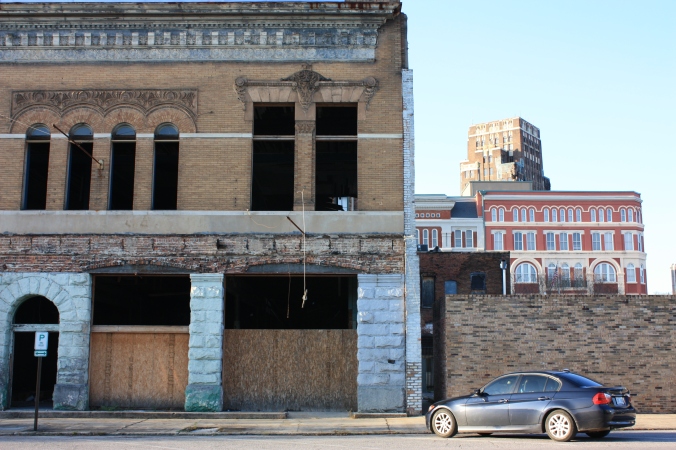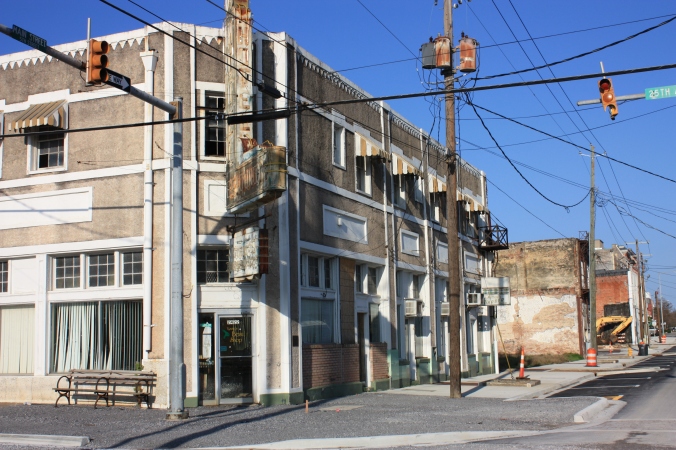
Former Citizens National Bank, December 2015 – photo by author
IN OCTOBER OF 2016, demolition began of a small but elegant building at 2212 4th Street in Meridian, MS. A few years before, the owner had removed the metal siding that had covered much of the ornate Romanesque façade since at least the 1970s. I had hoped someone was finally going to “do something” with the building – the last remaining structure on that side of the 2200 block of 4th Street. For a while there were rumors about a mixed-use development – apartments on the second floor with commercial space below – but those never materialized. The building continued to deteriorate. In October of last year, the backhoes showed up.

Ongoing demolition, December 2016 – photo by author
In the last decades of the 19th Century, 4th Street was known as Commerce Street. It played host to Meridian’s first opera house, the First National Bank, and various saloons, restaurants, and cotton brokers. The Romanesque building at 2212 4th Street was constructed some time before 1885, and it was built to impress with its rusticated granite base and ornamental stonework above. In the beginning it housed a grocery and office space, later a cigar manufacturer, harness shop, auctions house, restaurant, and jeweler.

Citizens Bank, c. 1902 – photo courtesy of Citizens National Bank. (The History section of the CNB website captions this photo ca. 1888, but Sanborn Maps do not show Citizens at 2212 4th Street until 1902. The 1889 Sanborn shows Citizens in the 2300 block of 4th Street.)
From 1902 until 1912, Citizens Savings Bank, later Citizens National Bank, occupied the building. The bank had only just incorporated in 1888 and had relocated from another building on 4th Street. Beginning in 1902, the Standard Club – a literary and musical society organized among the prominent male members of Meridian’s Jewish community – met on the second-floor, until constructing their own hall at 22nd Avenue and 10th Street around 1910. Citizens National Bank moved to its own building – a seven-story classical structure at 22nd Avenue and 4th Street – in 1912. Afterward 2212 4th Street served as Meridian’s American Legion Hall, at least from 1950 until 1979.

2212 4th Street (photo taken 1978) is located in the foreground to the left. A sign over the righthand door reads Legion, apparently referring to the American Legion – photo courtesy of the National Register of Historic Places.
By the 1970s it had gotten its metal siding “face-lift,” but the 1979 National Register nomination for the Meridian Urban Center Historic District still called it “one of the more remarkable district buildings.” It was a fine example of Romanesque architecture – on par in its detailing with the nearby Rosenbaum Building, though considerably smaller. It presented a surprising contrast to the run-of-the-mill Italianate storefront more common in the late nineteenth-century in general and in downtown Meridian in particular.
Before demolition began, there was some talk of the primary façade at least being saved and reused in the construction of a new building. I hope this is the case, but watching the process of the demolition from October to December, I have my doubts.

Former Citizens National Bank Building, October 2016 – photo by author
Sources:
Meridian Sanborn Maps. Mississippi Library Commission digital archives.
Meridian Urban Center Historic District Nomination Form (1979). National Register of Historic Places online archive.
1888 Meridian City Directory. Lauderdale County Department of Archives and History.


